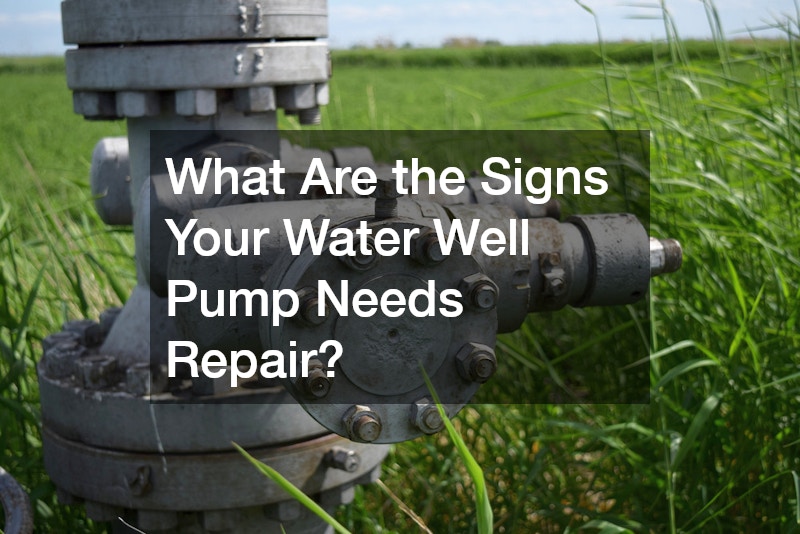
Water wells are a crucial source of water for millions of households, providing a reliable and self-sufficient water supply. However, like any other mechanical system, water well pumps require regular maintenance and occasional repairs to ensure optimal performance. In this article, we will explore the various signs that indicate your water well pump might need repair, helping you address potential issues before they escalate.
One of the most evident signs that your water well pump needs repair is a noticeable decrease in water pressure. If you find yourself adjusting the faucets more often than usual to get the desired flow, this could be a warning sign.
Video Source
Low water pressure can stem from several causes, such as clogged pipes, sediment buildup in the pump, or a malfunctioning pressure switch. To address this issue, it's essential to first identify the root cause to determine whether a simple cleaning or a more extensive repair is needed. Consistently monitoring your water pressure can help you catch such issues early, preventing further damage.
Another potential cause of decreased water pressure is the wear and tear on the pump itself. Over time, the components within the pump motor may become worn, leading to reduced efficiency in pumping water. Regular maintenance, such as lubricating moving parts and replacing worn-out components, can help extend the life of your pump. If the pump has reached the end of its operational life, replacing it might be the most effective solution. Engaging with professional water well pump repair services ensures you receive accurate diagnostics and quality repairs.
Unusual noises coming from your water well pump can be alarming and are often indicative of underlying problems. If you hear grinding, clanking, or rattling sounds while the pump is operating, it's a sign that something might be amiss. These noises could result from debris getting inside the pump, causing interference with moving parts. Alternatively, worn bearings or damage to vital components can also lead to strange sounds emanating from the pump. It's crucial to address the source of these noises to prevent further damage and ensure the continued functionality of your water well pump.
Ignoring strange noises can exacerbate the problem and potentially cause more significant issues within the pump. For instance, a failure to address worn bearings might lead to a complete pump breakdown, leaving you without a water supply. Furthermore, persistent noise issues can also signify that the pump is working harder than necessary, indicating inefficiency that can spike your electricity bills. By contacting experienced water well pump repair professionals, you can identify the source of the problem and implement solutions before it escalates. Regular inspections and maintenance can prevent such issues from developing in the first place.
If your pump is frequently cycling on and off, this irregular behavior is a strong indicator of a problem that needs addressing. Your water well pump should ideally remain off until it is needed, only turning on when the water storage tank requires refilling. Short-cycling, or the syndrome where the pump cycles rapidly, can strain the motor unnecessarily. This type of cycling might be due to defective pressure tank or pressure switch issues, both requiring prompt attention. Consistent monitoring of cycling patterns helps in maintaining the efficiency and lifespan of your well pump system.
Several factors can trigger inconsistent cycling, each with varying degrees of complexity in terms of repair. A manageable cause could be air leaks in the plumbing, which inhibit proper pressure maintenance. Alternatively, more severe issues like a malfunctioning switch or even an incorrect pump size relative to your water needs could be involved. Addressing these issues often calls for professional water well pump repair services that can accurately diagnose and resolve the situation. Tackling the root of the problem not only normalizes cycling patterns but also ensures optimal water usage.
Noticeably higher energy bills could signal an issue with your water well pump. Increased energy consumption suggests that your pump is working harder than it should, which is often due to inefficiency caused by a malfunction. This inefficiency could arise from aging components, a failing motor, or even obstructions or leaks that force the pump to work overtime. Addressing these inefficiencies not only conserves energy but also ensures that your pump is operating within normal parameters. Professional assessment is key to identifying the exact cause and implementing effective repairs.
An essential step in managing utility costs involves regular pump maintenance and timely repairs. Ignoring the problem can result in sustained high costs and potentially more extensive damage to the pump itself over time. By investing in regular checks, you can detect signs of wear and operational inefficiencies before they translate into higher expenses. Repairing or replacing essential components like impellers, bearings, or electrical components can significantly reduce energy consumption. Ultimately, this contributes to cost-effectiveness and eco-friendliness within your household utility management.
Beyond immediate savings on your energy bills, a well-maintained water well pump ensures a reliable, efficient water supply. This reduces the need for costly emergency repairs and extends the overall service life of the pump. Implementing a routine maintenance schedule with a reliable water well pump repair service can keep your system efficient. By safeguarding against inefficiencies, you benefit from a consistent water supply and predictable utility expenses, enhancing the long-term sustainability of your water well system.
